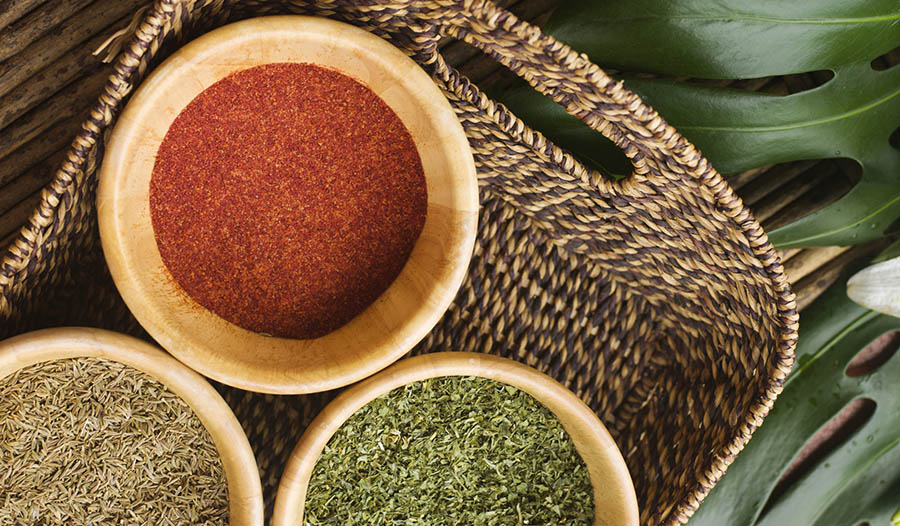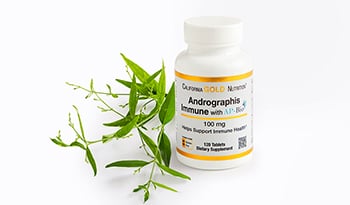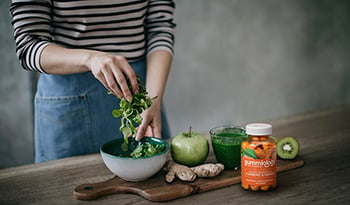How Spices Combat Inflammation and Benefit Health
DISCLAIMER:This blog does not intend to provide diagnosis...
- In this article:
- Herbs vs. Spices
- What Is Inflammation?
- Cayenne Pepper Benefits
- Cinnamon Benefits
- Cumin Benefits
- Ginger Benefits
- Turmeric Benefits

Originally posted April 2018 / Updated May 2023
Spices add a great deal of flavor to foods and our life! Several spices have powerful effects in reducing inflammation.
This article will focus on five superstar spices: cayenne pepper, cinnamon, cumin, ginger, and turmeric. These spices stand out for their culinary uses and health benefits, especially in supporting the body's response to inflammation.
Herbs vs. Spices
Before unpacking the benefits of spices, let's formally define the difference between a spice and an herb. Technically, an herb is a plant that does not have a woody stem. If a plant has a woody stem, it is referred to as a shrub, bush, or tree. The term "herb" is also used to describe a plant or plant part used for medicinal purposes. On the other hand, a spice technically describes a plant product with aromatic properties and is used to season or flavor foods.
Herbs used in cooking are typically composed of leaves and stems. This makes for an easy way of distinguishing herbs from spices, as most spices are derived from roots or rhizomes.
What Is Inflammation?
Inflammation is the body's response to injury or infection.
Most people are familiar with the signs and symptoms of acute inflammation. The redness, heat, pain, and swelling happen when you cut your finger, scrape your knee, have a throat infection, or have a flare-up of arthritis.
In acute inflammation, your body sends white blood cells to the site of injury or infection. This process is designed to start the healing process but also leads to inflammation and tissue damage.
In chronic inflammation, the intensity of the inflammatory process is less than in an acute situation, but it is persistent. Chronic inflammation, also known as silent inflammation, is a smoldering type of inflammation that is an underlying factor in many chronic health issues like obesity, heart disease, diabetes, and Alzheimer's disease.
Reducing inflammation throughout the body with diet is essential in promoting health and reducing the risk of chronic disease. Including these five superstar spices can go a long in that regard.
Cayenne Pepper Benefits
Cayenne pepper comes from the fruit of Capsicum annuum/longum, a shrubby tropical plant. The spice level of cayenne varies from mild, like paprika, to very hot and spicy. The determining factor is the content of capsaicin. The higher the capsaicin level, the greater it is hot and spicy. Cayenne pepper is the chief ingredient in chili powder.
In terms of health benefits, cayenne pepper has many. Capsaicin-containing creams and gels are FDA-approved for the relief of arthritis and the pain of the after-effects of shingles (post-herpetic neuralgia) and diabetic neuropathy.
Cayenne pepper stimulates and enhances digestion, exerts beneficial effects on the heart and blood vessels, enhances metabolism and the burning of fat for energy, and helps to support blood sugar control.
Regarding inflammation, internally, cayenne pepper's anti-inflammatory effects are most apparent in protecting against the silent inflammation associated with heart disease, obesity, and poor blood sugar control.
Cayenne peppers are available as whole fresh, whole dried, crushed dried, or ground. Paprika is available dried and ground. Like other dried spices, choose organically grown dried cayenne pepper when possible since organically grown herbs are much less likely to have been irradiated.
Cinnamon Benefits
Cinnamon comes from the inner bark of evergreen trees native to southwest India and Asia. Cinnamon is one of the oldest spices known and has a long history of use in both Eastern and Western cultures as a medicine.
The most popular modern use of cinnamon is in supporting blood sugar control, which has been confirmed in several double-blind clinical studies. These beneficial compounds survive the digestive process and have been shown to reduce the inflammation that leads to loss of the integrity of the intestinal barrier leading to what is referred to as a "leaky gut." Cinnamon polyphenols reduce the activity of NF-κB (nuclear factor kappa-light-chain-enhancer of activated B cells). NF-κB is a protein complex that sends a message to the cell nucleus that promotes the production of inflammatory compounds. Blocking NF-κB activity has great significance in reducing overall inflammation.
Cinnamon has a naturally sweet flavor and is the perfect choice to add to yogurt, whole-wheat toast, or cereal. It complements bold flavors well and makes a nice addition to soups or chili. A bit of cinnamon can also make a great addition to a latte.
Coconut Cinnamon Latte Recipe
Ingredients:
- 12 ounces of strong coffee
- 1/4 tsp. cinnamon
- 1 tsp. MCT oil
- stevia to taste
- 1-2 Tbs. full-fat coconut milk or creamer, optional
Instructions:
- Combine all ingredients.
- Blend with a handheld mixer until slightly frothy, and drink immediately.
Serves one.
For additional cinnamon flavor and health benefits, consider adding a dash of cinnamon to the coffee grounds while brewing.
Cumin Benefits
Cumin is a spice from the Cuminum cyminum plant commonly used in many spice blends, such as chili and curry powder. It adds a warm flavor and works well in soups, stews, and curries. It is very popular in Latin America, Africa, and Asia dishes. Cumin also packs a powerful antioxidant and anti-inflammatory punch.
Like other ingredients in chili and curry powder, cumin has shown weight-loss-promoting effects, practical actions in blood sugar control, and heart health benefits.
Cumin can be simple to add to daily meals. Add red beans or kidney beans to a salad, and sprinkle a dash of cumin on top. Add a bit of cumin to scrambled eggs and top with organic salsa. Try this quinoa and black bean chili recipe for an easy, flavor-packed cumin recipe.
Spicy Quinoa and Black Bean Chili Recipe
Ingredients:
- 2 cups cooked quinoa
- 15-ounce canned organic black beans, rinsed and drained
- ½ can tomato paste
- 1 tsp. cumin
- 1 tsp. garlic powder
- 1 Tbs. chili powder
- ¼ tsp. oregano
- ¼ tsp. onion powder
- ¼ tsp. paprika
- dash of cayenne pepper, optional
- ¼-1/2 cup of water, optional
Instructions:
- Combine all ingredients except the cayenne pepper and water in a medium-sized pot on the stove over medium-high heat until heated thoroughly. Add the cayenne pepper as desired.
- Slowly add water until the desired consistency is achieved; some prefer a more broth-based chili, while others prefer a thicker mixture.
- Simmer for 15 minutes to let flavors combine.
Serves four.
Ginger Benefits
Ginger (Zingiber officinale) is an erect perennial herb with thick tuberous rhizones (underground stems and roots). It originated in southern Asia and is now extensively cultivated throughout Asia and the tropics (e.g., India, Jamaica, Haiti, and Nigeria).
Historically, ginger was used to benefit the gastrointestinal system. Ginger is regarded as an excellent carminative (a substance that promotes the elimination of intestinal gas) and intestinal spasmolytic (a substance that relaxes and soothes the intestinal tract).
Ginger has also been shown to be a potent inhibitor of forming inflammatory compounds. These effects have translated to positive results in over 100 clinical studies. Specifically, ginger exerts significant anti-inflammatory actions that can help ease joint discomfort, headaches, and menstrual cramps. In addition to these benefits in acute inflammation, ginger has demonstrated anti-inflammatory effects significant in chronic inflammation, especially the underlying mechanisms that negatively affect cardiovascular and metabolic health.
Turmeric Benefits
Turmeric (Curcuma longa) is a ginger family member extensively cultivated in India, China, Indonesia, and other tropical countries. Like ginger, the rhizome (root) is the part that is utilized. Turmeric is the primary ingredient of curry powder and is also used in prepared mustard as a coloring agent. It is extensively used in a variety of foods both for its color and flavor.
Curcumin, turmeric's yellow pigment, has been the subject of over 8,000 published scientific studies over the last 20 years. Most of these studies have focused on its anti-inflammatory effects in experimental models. In addition to being helpful in improving joint function and pain, curcumin has also been shown to exert general anti-inflammatory actions. It is particularly helpful in preventing LDL cholesterol from becoming oxidized and damaging arteries.
Curcumin is also helpful in fighting inflammation and aging in the brain. Researchers began exploring this effect after noting that elderly (aged 70-79) residents of rural India who eat large amounts of turmeric have been shown to have the lowest rate of age-related memory loss and Alzheimer's disease in the world: 4.4 times lower than that of Americans.
Turmeric Smoothie Recipe
Ingredients:
- 1 tsp. turmeric
- 1 tsp. coconut oil
- ½ cup frozen raspberries
- ½ ripe banana
- 1 cup coconut milk
- stevia or other low-glycemic index sweetener to taste
Instructions:
- Combine ingredients in a high-speed blender. Blend for 30 seconds.
Serves one.
References:
- Bal S, Sharangi AB, Upadhyay TK, et al. Biomedical and Antioxidant Potentialities in Chilli: Perspectives and Way Forward. Molecules. 2022 Sep 27;27(19):6380.
- Shang C, Lin H, Fang X, et al. Beneficial effects of cinnamon and its extracts in the management of cardiovascular diseases and diabetes. Food Funct. 2021 Dec 13;12(24):12194-12220.
- Pagliari S, Forcella M, Lonati E, et al. Antioxidant and Anti-Inflammatory Effect of Cinnamon (Cinnamomum verum J. Presl) Bark Extract after In Vitro Digestion Simulation. Foods. 2023 Jan 18;12(3):452.
- Singh N, Yadav SS, Kumar S, Narashiman B. A review on traditional uses, phytochemistry, pharmacology, and clinical research of dietary spice Cuminum cyminum L. Phytother Res. 2021 Sep;35(9):5007-5030.
- Daniels CC, Isaacs Z, Finelli R, Leisegang K. The efficacy of Zingiber officinale on dyslipidaemia, blood pressure, and inflammation as cardiovascular risk factors: A systematic review. Clin Nutr ESPEN. 2022 Oct;51:72-82. Doi: 10.1016/j.clnesp.2022.08.031. Epub 2022 Sep 3. PMID: 36184251.
- Zhang X, Deng J, Tang Y, Guan X, Chen X, Fan J. Zingiberaceae plants/curcumin consumption and multiple health outcomes: An umbrella review of systematic reviews and meta-analyses of randomized controlled trials in humans. Phytother Res. 2022 Aug;36(8):3080-3101.
- Kunnumakkara AB, Hegde M, Parama D, et al. Role of Turmeric and Curcumin in Prevention and Treatment of Chronic Diseases: Lessons Learned from Clinical Trials. ACS Pharmacol Transl Sci. 2023 Mar 6;6(4):447-518.
- Berry A, Collacchi B, Masella R, et al. Curcuma Longa, the "Golden Spice" to Counteract Neuroinflammaging and Cognitive Decline-What Have We Learned and What Needs to Be Done. Nutrients. 2021 Apr 30;13(5):1519.

 By Dr. Michael Murray, N.D.
By Dr. Michael Murray, N.D. 


